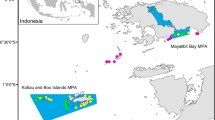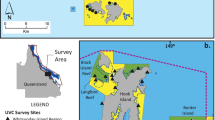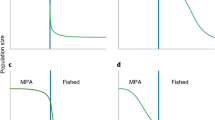Abstract
Marine ecological services provide goods, amenities, food resources, and economic benefits to millions of people globally. The loss of these services, attributed to the infiltration of marine invasive species such as the Indo-Pacific lionfish (Pterois volitans/miles), is measurable. The highly successful lionfish now flourishes in great densities in the US Gulf of Mexico and Atlantic waters and the entire Caribbean, yet the loss of ecological services attributed to the invader has not yet been assessed. In this study, we employ a derivative of a well-utilized method of ecosystem valuation known as habitat equivalency analysis to measure the time-value-adjusted loss of biomass- and recruitment-related ecosystem services brought by lionfish to Bahamian reefs. Drawing upon the literature examples of tangible lionfish damages in the Bahamas, we (1) quantitatively evaluate the loss of ecosystem services instigated by lionfish by measuring the total service-year losses partitioned over yearly time steps, (2) provide a metric by which ocean managers may value the remunerations of Bahamian lionfish controls when weighed against removal costs, and (3) deliver a tool to quantify changes in ecosystem services as a consequence of invasive species impacts and control. We found that the invader imposed losses of 26.67 and 21.67 years to recruitment and biomass services per km2 of Bahamian reef if left uncontrolled. In the same accord, the most conservative Bahamian lionfish removal regime modeled, i.e., which produced a 50 % recovery of pre-lionfish ecosystem function over 10 years, provided service gains of 9.57 and 4.78 years per km2. These data deliver a platform upon which to quantify present and future fiscal costs of the lionfish invasion and also to value lionfish control efforts.


Similar content being viewed by others
References
Akins L, Lazarre D, Die D, Morris J (2012) Lionfish Bycatch in The Florida Lobster Fishery: first Evidence of Occurrence and Impacts. Proc Gulf Caribb Fish Inst 65:329–330
Albins MA (2015) Invasive Pacific lionfish Pterois volitans reduce abundance and species richness of native Bahamian coral-reef fishes. Mar Ecol Prog Ser 522:231–243
Albins MA, Hixon MA (2008) Invasive Indo-Pacific lionfish Pterois volitans reduce recruitment of Atlantic coral-reef fishes. Mar Ecol Prog Ser 367:233–238
Barbour AB, Allen MS, Frazer TK, Sherman KD (2011) Evaluating the potential efficacy of invasive lionfish (Pterois volitans) removals. PLoS One 6(5):e19666
Brander LM, Van Beukering P, Cesar HS (2007) The recreational value of coral reefs: a meta-analysis. Ecol Econ 63(1):209–218
Cesar H, Burke L, Pet-Soede L (2003) The economics of worldwide coral reef degradation. Cesar Environmental Economics Consulting, The Netherlands
Darling ES, Green SJ, O’Leary JK, Côté IM (2011) Indo-Pacific lionfish are larger and more abundant on invaded reefs: a comparison of Kenyan and Bahamian lionfish populations. Biol Invasions 13(9):2045–2051
de León R, Vane K, Bertuol P, Chamberland VC, Simal F, Imms E, Vermeij MJ (2013) Effectiveness of lionfish removal efforts in the southern Caribbean. Endanger Species Res 22:175–182
Dunford RW, Ginn TC, Desvousges WH (2004) The use of habitat equivalency analysis in natural resource damage assessments. Ecol Econ 48(1):49–70
Frazer TK, Jacoby CA, Edwards MA, Barry SC, Manfrino CM (2012) Coping with the lionfish invasion: can targeted removals yield beneficial effects? Rev Fish Sci 20(4):185–191
Green SJ, Côté IM (2009) Record densities of Indo-Pacific lionfish on Bahamian coral reefs. Coral Reefs 28(1):107
Green SJ, Akins JL, Maljković A, Côté IM (2012) Invasive lionfish drive Atlantic coral reef fish declines. PLoS One 7(3):e32596
Green SJ, Dulvy NK, Brooks AL, Akins JL, Cooper AB, Miller S, Côté IM (2014) Linking removal targets to the ecological effects of invaders: a predictive model and field test. Ecol Appl 24(6): 1311–1322
Holmlund CM, Hammer M (1999) Ecosystem services generated by fish populations. Ecol Econ 29(2):253–268
Morris JA Jr, Whitfield PE (2009) Biology, ecology, control and management of the invasive Indo-Pacific lionfish: an updated integrated assessment. NOAA Technical Memorandum NOS NCCOS 99
Jaap WC (2000) Coral reef restoration. Ecol Eng 15(3):345–364
Jackson JBC, Donovan MK, Cramer KL, Lam VV (eds) (2014) Status and trends of caribbean coral reefs: 1970–2012. Global Coral Reef Monitoring Network. IUCN, Gland
Johnston MW, Purkis SJ (2014) Lionfish in the eastern Pacific: a cellular automaton approach to assessing invasion risk. Biol Invasions 16(12):2681–2695
Johnston MW, Purkis SJ (2015) A coordinated and sustained international strategy is required to turn the tide on the Atlantic lionfish invasion. Mar Ecol Prog Ser 533:219–235. doi:10.3354/meps11399
Kohler KE, RE Dodge (2006) Visual_HEA: habitat equivalency analysis software to calculate compensatory restoration following natural resource injury. In: Proceedings of the 10th international coral reef symposium. Okinawa, Japan, pp 1611–1616
Leung B, Lodge DM, Finnoff D, Shogren JF, Lewis MA, Lamberti G (2002) An ounce of prevention or a pound of cure: bioeconomic risk analysis of invasive species. Proc R Soc Lond B Biol Sci 269(1508):2407–2413
Milon JW, Dodge RE (2001) Applying habitat equivalency analysis for coral reef damage assessment and restoration. Bull Mar Sci 69(2):975–988
Morris JA Jr, Akins JL (2009) Feeding ecology of invasive lionfish (Pterois volitans) in the Bahamian archipelago. Environ Bio Fishes 86:389–398
Morris JA Jr, Shertzer KW, Rice JA (2011) A stage-based matrix population model of invasive lionfish with implications for control. Biol Invasions 13:7–12
Peterson CH, Lubchenco J (1997) Marine ecosystem services. Island Press, Washington, pp 177–195
Pimentel D, Zuniga R, Morrison D (2005) Update on the environmental and economic costs associated with alien-invasive species in the United States. Ecol Econ 52(3):273–288
Reaser JK, Meyerson LA, Cronk Q, De Poorter M, Eldrege LG, Green E, Kairo M et al (2007) Ecological and socioeconomic impacts of invasive alien species in island ecosystems. Environ Conserv 34(02):98–111
ReefBase: A Global Information System for Coral Reefs (2014). http://www.reefbase.org
Semmens BX, Buhle ER, Salomon AK, Pattengill-Semmens CV (2004) A hotspot of non-native marine fishes: evidence for the aquarium trade as an invasion pathway. Mar Ecol Prog Ser 266(1):239–244
Sibbing JM (2005) Mitigation Banking: will the Myth Ever Die? Natl Wetl Newsl 27(6):5–6
USGS-NAS (2014) United States Geological Survey-Nonindigenous Aquatic Species database (USGS-NAS). http://nas.er.usgs.gov. Accessed 4 Nov 2014
Valdez-Moreno M, Quintal-Lizama C, Gómez-Lozano R, del Carmen García-Rivas M (2012) Monitoring an alien invasion: DNA barcoding and the identification of lionfish and their prey on coral reefs of the Mexican Caribbean. PLoS One 7(6):e36636
Viehman S, Thur SM, Piniak GA (2009) Coral reef metrics and habitat equivalency analysis. Ocean Coast Manag 52(3):181–188
Worm B, Barbier EB, Beaumont N, Duffy JE, Folke C, Halpern BS, Jackson JC, Lotze HK, Micheli F, Palumbi SR, Sala E, Selkoe KA, Stachowicz Watson R (2006) Impacts of biodiversity loss on ocean ecosystem services. Science 314(5800):787–790
Acknowledgments
We thank the National Coral Reef Institute for their support of this investigation. Funding for this study was provided by the Guy Harvey Research Institute. This is NCRI publication #177.
Author information
Authors and Affiliations
Corresponding author
Additional information
Responsible Editor: E. Briski.
Reviewed by undisclosed experts.
This article is part of the Topical Collection on Invasive Species.
Rights and permissions
About this article
Cite this article
Johnston, M.W., Purkis, S.J. & Dodge, R.E. Measuring Bahamian lionfish impacts to marine ecological services using habitat equivalency analysis. Mar Biol 162, 2501–2512 (2015). https://doi.org/10.1007/s00227-015-2745-2
Received:
Accepted:
Published:
Issue Date:
DOI: https://doi.org/10.1007/s00227-015-2745-2




